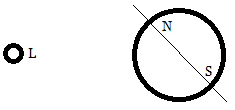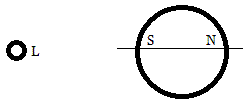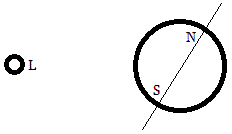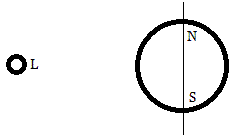|
| 1 |
Go |
Q:
|
In a gas, assume that the mass of each molecule is 10-5 kg and each molecule travels at 1 m/s. Utilizing the de Broglie wavelength equation λ = h/(mv), what is the wavelength of each gas particle? Assume that Planck's Constant is h = 7 x 10-34. |
|
A
|
7 x 1029 m |
B
|
7 x 10-29 m |
C
|
7 x 10-30 m |
D
|
7 x 10-31 m |
|
|
|
Tags:
Gases | Electromagnetics | |
|
| 2 |
Go |
Q:
|
How many carbon peaks would the molecule 3-ethyl-2-methylheptane show in its C-NMR? |
|
|
|
|
Tags:
Electromagnetics | |
|
| 3 |
Go |
Q:
|
What is the frequency of a wave traveling in a vacuum at a wavelength of 10m? |
|
A
|
3x108 Hz |
B
|
0.1 Hz |
C
|
3x107 Hz |
D
|
10-3 Hz |
|
|
|
Tags:
Electromagnetics | |
|
| 4 |
Go |
Q:
|
During atomic absorption spetroscopy, the concentration of certain atoms can be measured in very low concentrations. The absorption is tuned to the optimal absorption wavelength of individual metals. Will atomic absorption spectroscopy be useful for the measurement of ethanol in pure water? |
|
A
|
Yes because a mixture of ethanol and water does not have metal ions |
B
|
Yes because ethanol and water mixtures contain metal ions |
C
|
No because a mixture of ethanol and water does not have metal ions |
D
|
No because ethanol and water mixtures contain metal ions |
|
|
|
Tags:
Electromagnetics | Solutions | Alcohols | |
|
| 5 |
Go |
Q:
|
A light source at a point P emits radiation in all directions evenly. Two objects sit a distance of r1 and r2 away from P where r2 > r1. The change in the amount of radiation received between r1 and r2 is directly proportional to: |
|
A
|
(r2-r1)2 |
B
|
r2-r1 |
C
|
the change in surface area of spheres drawn with radii r1 and r2 |
D
|
the change in volume of spheres drawn with radii r1 and r2 |
|
|
|
Tags:
Electromagnetics | |
|
| 6 |
Go |
Q:
|
A positive charge moves in the positive x direction in a magnetic field pointing in the negative y direction. What is the direction of the force on the object? |
|
A
|
positive z direction |
B
|
negative z direction |
C
|
clockwise around the direction of motion |
D
|
counterclockwise around the direction of motion |
|
|
|
Tags:
Electromagnetics | |
|
| 7 |
Go |
Q:
|
Which of the following colors has the highest energy? |
|
A
|
Blue |
B
|
Green |
C
|
Yellow |
D
|
Red |
|
|
|
Tags:
Electromagnetics | |
|
| 8 |
Go |
Q:
|
An asteroid is being tracked by a astronomer. The astronomer wishes to ascertain the distance the asteroid is from his telescope. The asteroid is at an angle of 60 degrees to the horizon with respect to the telescope. The telescope shines a laser on the asteroid, and sees that it took 0.02 seconds for the light to hit the asteroid and return. What is the distance of the asteroid from the telescope? |
|
A
|
6x106sin(60°) m |
B
|
3x106sin(60°) m |
C
|
6x106 m |
D
|
3x106 m |
|
|
|
Tags:
Electromagnetics | Quantitative Skills | |
|
| 9 |
Go |
Q:
|
Cone cells in our eyes detect the quality and quantity of light. When detecting differing levels of brightness of reflected light, what property of the light is being sensed? |
|
A
|
Quantity of photons |
B
|
Wavelength of photons |
C
|
Frequency of photons |
D
|
Phase of photons |
|
|
|
Tags:
Electromagnetics | Sensory Processing | |
|
| 10 |
Go |
Q:
|
When light travels from air to water, which of the following occurs? |
|
A
|
Frequency changes |
B
|
Wavelength changes |
C
|
Energy changes |
D
|
Energy decreases but only to a minimal extent |
|
|
|
Tags:
Fluids | Gases | Electromagnetics | |
|
| 11 |
Go |
Q:
|
The circle on the right of the images shown represents a planet spinning on its axis drawn as a line through the circle. The left circle represents a light source. The northern and southern hemispheres are labeled N and S. Within one full rotation, which of the four schematics would shed the most light on any given spot on the northern hemisphere over the course of the rotation, given a constant speed of rotation? |
|
|
|
|
Tags:
Electromagnetics | |
|
| 12 |
Go |
Q:
|
Fluorescence is produced when a molecule enters an excited state and releases a photon of a particular wavelength. Which of the following colors of fluorescence would be indicative of the lowest energy? |
|
A
|
Red |
B
|
Blue |
C
|
Violet |
D
|
Green |
|
|
|
Tags:
Electromagnetics | |
|
| 13 |
Go |
Q:
|
One method for measuring the concentration of an analyte is to pass light through the sample and to measure how much is lost. This is known as percent transmission. Another method is pass light through the sample and to measure light at a longer wavelength (lower energy) than the incident light (the light shone onto the sample). What property of the analyte is being measured when a longer wavelength is measured (as opposed to percent transmission)? |
|
A
|
fluorescence |
B
|
absorbance |
C
|
color |
D
|
density |
|
|
|
Tags:
Electromagnetics | |
|
| 14 |
Go |
Q:
|
Cone cells in our eyes detect the quality and quantity of light. When detecting differing levels of brightness of reflected light, what property of the light is being sensed? |
|
A
|
Quantity of photons |
B
|
Wavelength of photons |
C
|
Frequency of photons |
D
|
Phase of photons |
|
|
|
Tags:
Nervous System | Electromagnetics | Sensory Processing | |
|
| 15 |
Go |
Q:
|
Which is a feature of gamma rays? |
|
A
|
They have the longest wavelength in the electromagnetic spectrum |
B
|
They have the least energy in the electromagnetic spectrum |
C
|
They are emitted by electrons from outside the nucleus |
D
|
They can kill cells |
|
|
|
Tags:
Electromagnetics | |
|
| 16 |
Go |
Q:
|
The Beer-Lambert law suggests which of the following? |
|
A
|
The greater the path length, the higher the molar absorptivity |
B
|
The greater the molar absorptivity, the higher the concentration |
C
|
The greater the concentration, the higher the absorbance value |
D
|
The greater the absorbance value, the higher the molecular weight |
|
|
|
Tags:
Electromagnetics | |
|
| 17 |
Go |
Q:
|
Which of the following is not a feature of all waves? |
|
A
|
They transport energy through space |
B
|
They have an amplitude |
C
|
They have a frequency |
D
|
They transport mass through space |
|
|
|
Tags:
Electromagnetics | |
|
| 18 |
Go |
Q:
|
A charge of 3 C moves at 10 m/s through a magnetic field of 10 T. What is the maximum force it can experience assuming varied angles of passage through the magnetic field? |
|
A
|
3 N |
B
|
30 N |
C
|
300 N |
D
|
3000 N |
|
|
|
Tags:
Electromagnetics | Quantitative Skills | |
|
| 19 |
Go |
Q:
|
What is the energy of an electromagnetic wave with energy E if the wavelength is changed from 800 nm to 400 nm? |
|
|
|
|
Tags:
Electromagnetics | |
|
| 20 |
Go |
Q:
|
Electromagnetic radiation is a |
|
A
|
transverse wave only |
B
|
longitudinal wave only |
C
|
longitudinal and transverse wave |
D
|
longitudinal or transverse wave |
|
|
|
Tags:
Electromagnetics | |
|
| 21 |
Go |
Q:
|
Hydrogen has an emission spectrum at the following wavelengths for photons emitted when an electron drops in energy levels. Which of the emissions is associated with the lowest drop in energy?
| I | 652 nm |
| II | 486 nm |
| III | 434 nm |
| IV | 410 nm |
|
|
|
|
|
Tags:
Electromagnetics | |
|
| 22 |
Go |
Q:
|
An organic compound absorbs light at 535 nm (green) and is oxidized, breaking its conjugation. The new compound absorbs light at a higher energy. Which of the following is a plausible absorbance wavelength for the new compound? |
|
A
|
280 nm |
B
|
535 nm |
C
|
740 nm |
D
|
The answer cannot be determined with the given information. |
|
|
|
Tags:
Electromagnetics | |
|
| 23 |
Go |
Q:
|
Which of the following statements regarding waves is FALSE? |
|
A
|
Light experiences diffraction but sound does not. |
B
|
Light slows down as it moves from air to water but sound speeds up. |
C
|
Light is a transverse wave while sound is a longitudinal wave. |
D
|
Both light and sound have a period, frequency, and a wavelength. |
|
|
|
Tags:
Electromagnetics | |
|
| 24 |
Go |
Q:
|
If the directions of the magnetic field and the movement of a charge in that field are parallel, the force experienced by the charge will be equal to (Note: q is the magnitude of the point charge, v is the velocity of the charge, and B is the magnitude of the magnetic field): |
|
|
|
|
Tags:
Electromagnetics | |
|
| 25 |
Go |
Q:
|
A positively-charged particle is found to be moving in the same direction as a magnetic field toward the top of the page. The direction of the force that the particle experiences is: |
|
A
|
into the page |
B
|
out of the page |
C
|
towards the top of the page. |
D
|
the particle does not experience any force from the magnetic field. |
|
|
|
Tags:
Electromagnetics | |
|
| 26 |
Go |
Q:
|
A researcher is examining an energy source and is determining the type of wave emitted. She observes that the wave is unable to propagate in a vacuum. If the wave is placed in front of a barrier with a single thin slit, the wave diffracts out of the slit. Upon observing movement, she finds the particles do not oscillate in the direction of the motion of the wave. Based on these observations, she can most safely conclude the wave is a |
|
A
|
transverse wave |
B
|
longitudinal wave |
C
|
both transverse and longitudinal |
D
|
neither transverse nor longitudinal |
|
|
|
Tags:
Electromagnetics | |
|
| 27 |
Go |
Q:
|
Which of the following occurs with light but not with sound? |
|
A
|
Doppler effect |
B
|
Diffraction |
C
|
Refraction |
D
|
Travel through vacuum |
|
|
|
Tags:
Sound | Electromagnetics | |
|
| 28 |
Go |
Q:
|
Diffraction of light through a single slit demonstrates that light: |
|
A
|
has particle-like behavior |
B
|
also is subject to the Doppler effect |
C
|
changes its angle as it goes from one medium to another |
D
|
has wave-like behavior |
|
|
|
Tags:
Electromagnetics | |
|
| 29 |
Go |
Q:
|
A continuous wave (of sinusoidal pattern) is emitted from a source and a receiver stands 1000 meters away from the source. The receiver is able to measure the amplitude of the signal. Data from the receiver shows that the time between each maximum amplitude is 4 seconds. When the wave is graphically depicted, it is found that the distance between the adjacent highest and lowest amplitude is 3 cm. Which of the following is the speed of this wave? |
|
A
|
1.5 cm/s |
B
|
3 cm/s |
C
|
0.75 cm/s |
D
|
12 cm/s |
|
|
|
Tags:
Electromagnetics | Quantitative Skills | |
|
| 30 |
Go |
Q:
|
Which of the following colors of light has the lowest frequency? |
|
A
|
Red |
B
|
Orange |
C
|
Yellow |
D
|
Green |
|
|
|
Tags:
Electromagnetics | |
|
| 31 |
Go |
Q:
|
A beam of light traveling through air is first refracted by a lens and then reflected by an imperfect mirror (i.e., some of the energy from the photons are absorbed by the mirror). Which of the following remains constant at the start and end of the experiment?
I. wavelength
II. frequency
III. speed |
|
A
|
I and II only |
B
|
III only |
C
|
I, II, and III |
D
|
II and III only |
|
|
|
Tags:
Electromagnetics | Optics | |
|
| 32 |
Go |
Q:
|
A wave has a frequency of 7x107 Hz and a speed of 2x109 m/s. What is the approximate wavelength of this wave? |
|
A
|
30 cm |
B
|
300 cm |
C
|
3000 cm |
D
|
30000 cm |
|
|
|
Tags:
Electromagnetics | |
|
| 33 |
Go |
Q:
|
An experiment shows that electron beams can pass undeflected through perpendicular electric and magnetic fields. If changed, which of the following will NOT affect either the electric or magnetic forces? |
|
A
|
Sign of charge of the particles |
B
|
Magnitude of charge of the particles |
C
|
Mass of the particles |
D
|
Velocity of the particles |
|
|
|
Tags:
Electromagnetics | Magnetism | |
|
| 34 |
Go |
Q:
|
Which of the following correctly shows the relationship between electromagnetic waves in terms of frequency? |
|
A
|
Radio > ultraviolet > gamma rays |
B
|
Gamma rays > ultraviolet > radio |
C
|
Radio > infrared > optical |
D
|
Gamma rays > infrared > optical |
|
|
|
Tags:
Electromagnetics | |
|
| 35 |
Go |
Q:
|
In the circuit below, a conductor is connected to a battery as shown. The conductor is in a magnetic field that is coming out of the page. If electrons are the charge carriers in this conductor, which of the following is true regarding the direction of the force that the electrons experience?
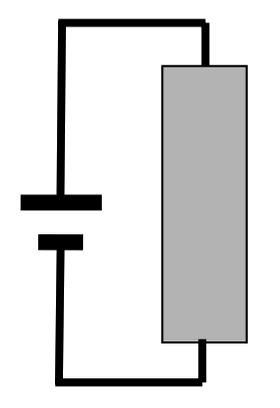 |
|
A
|
The electrons do not experience a force from the magnetic field.
|
B
|
The electrons experience a magnetic force into the page.
|
C
|
The electrons experience a magnetic force out of the page.
|
D
|
The electrons experience a magnetic force to the left.
|
|
|
|
Tags:
Circuits | Electromagnetics | |
|
| 36 |
Go |
Q:
|
Doubling the wavelength of a wave on a string results in its: |
|
A
|
speed being halved, but its frequency remaining constant.
|
B
|
frequency being halved, but its speed remaining constant.
|
C
|
speed doubling, but its frequency remaining constant.
|
D
|
frequency doubling, but its speed remaining constant.
|
|
|
|
Tags:
Electromagnetics | |
|
| 37 |
Go |
Q:
|
Radar can detect the velocity of an object by emitting brief pulses of radio waves and detecting the frequency that returns. The detected waves are Doppler shifted and should be: |
|
A
|
a higher frequency if the object is moving toward the radar source. |
B
|
a lower frequency if the object is moving toward the radar source. |
C
|
a higher frequency if the object is small. |
D
|
detectable only if there are no other objects in the vicinity. |
|
|
|
Tags:
Electromagnetics | |
|
| 38 |
Go |
Q:
|
A wave of energy E is emitted from a transmitter 10 m from an object. The wavelength is decreased from 1000 nm to 250 nm and the transmitter is moved such that it is 5 m from the object. Which of the following correctly represents the energy of the energy of this new wave? |
|
|
|
|
Tags:
Electromagnetics | |
|
| 39 |
Go |
Q:
|
Which of the following represents a difference between magnetism and electricity? |
|
A
|
The strength of attraction or repulsion is inversely related to the square root of the distance between the two charges or poles
|
B
|
The strength of attraction or repulsion between two poles or charges is of equal value
|
C
|
The ability to isolate positive and negative charges from one another versus isolating opposing magnetic poles from one another
|
D
|
Whether or not like poles or charges repel or attract one another
|
|
|
|
Tags:
Electromagnetics | |
|
|
We can teach you how to crush the MCAT!
Learn More
|

